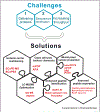Single-cell protein analysis by mass spectrometry
- PMID: 32599342
- PMCID: PMC7767890
- DOI: 10.1016/j.cbpa.2020.04.018
Single-cell protein analysis by mass spectrometry
Abstract
Human physiology and pathology arise from the coordinated interactions of diverse single cells. However, analyzing single cells has been limited by the low sensitivity and throughput of analytical methods. DNA sequencing has recently made such analysis feasible for nucleic acids but single-cell protein analysis remains limited. Mass spectrometry is the most powerful method for protein analysis, but its application to single cells faces three major challenges: efficiently delivering proteins/peptides to mass spectrometry detectors, identifying their sequences, and scaling the analysis to many thousands of single cells. These challenges have motivated corresponding solutions, including SCoPE design multiplexing and clean, automated, and miniaturized sample preparation. Synergistically applied, these solutions enable quantifying thousands of proteins across many single cells and establish a solid foundation for further advances. Building upon this foundation, the SCoPE concept will enable analyzing subcellular organelles and posttranslational modifications, while increases in multiplexing capabilities will increase the throughput and decrease cost.
Keywords: Isobaric carrier; Mass-spectrometry; Sample preparation; Single-cell analysis; Single-cell proteomics; Systems biology.
Copyright © 2020 Elsevier Ltd. All rights reserved.
Figures


References
-
- Cravatt BF, Simon GM, Yates Iii JR (2007) The biological impact of mass-spectrometry-based proteomics. Nature 450: 991. - PubMed
Publication types
MeSH terms
Substances
Grants and funding
LinkOut - more resources
Full Text Sources
Other Literature Sources

